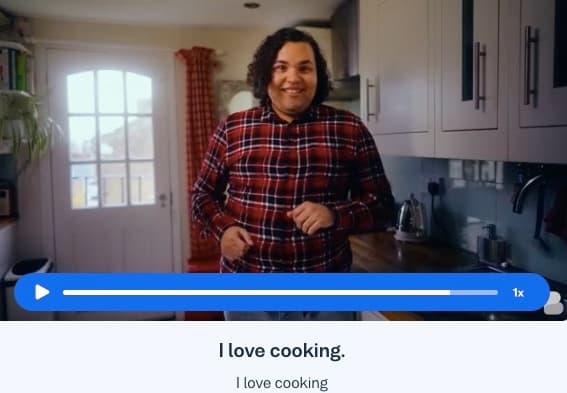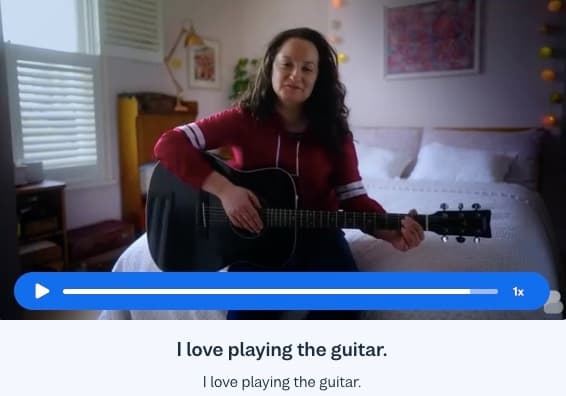I want to learn...
Author:

Barney Meekin
Understanding English sentence structure will help you communicate more effectively. And the good news is, you don’t need to learn complex grammar rules to build sentences in English. With a basic understanding of the building blocks of English sentences, you can express yourself more confidently and effectively in English conversations.
In this beginner’s guide, you’ll learn how to build easy-to-understand English sentences, the different types of English sentence structures, and some common mistakes you need to avoid.
English sentence structure: Subject, verb, object
Let's start with the basic parts of any sentence: The subject, verb and object, or SVO. SVO lays the foundation of English sentences. All sentences include a subject and verb (except imperative sentences like “Be quiet!” which don’t need a subject). Sentences might also include an object.
In English sentences, the subject generally comes first, then the verb, and finally the object. Most sentences stick to the SVO order. Here’s a quick recap of these three parts:
Subject: This is the focus of your sentence, the person, place, or thing that the verb describes. It’s always a noun or pronoun.
Verb: Verbs in sentences have two purposes. They add action by telling us what the subject is doing. Or they describe the subject (these are called linking verbs). There are two types of action verbs: Transitive and intransitive. Transitive verbs must have an object. Intransitive verbs are the opposite — they don’t need objects. (Brush up on your irregular verbs here).
Object. There are two types of objects - direct and indirect. Direct objects answer the questions, “what?” or “whom?” And indirect objects answer the questions, “for what?” “for whom?” “to what?” etc.
This sounds complicated but don’t worry, take a look at some examples below to help you.
“He wasn’t late for class.”
The subject is “he” because that’s the focus of the sentence.
The verb is “wasn’t” which is a linking verb. It describes the subject.
There are no objects in the sentence because linking verbs don’t need one."The cat jumped."
The subject is “The cat.”
The verb is “jumped.” It describes an action.
There are no objects in this sentence because “jump” is an intransitive verb.“Taylor Swift watched the Super Bowl.”
The subject is “Taylor Swift.”
The verb is “watched.”
The direct object is “the Super Bowl.” You can tell it’s the direct object because it answers the question “What did Taylor Swift watch?”“She gave the cake to John.”
The subject is “She.”
The verb is “gave.”
The direct object is “cake.” You can tell it’s the direct object because it answers the question “What did she give?”
The indirect object is “John.” You can tell it’s the indirect object because it answers the question “Who did she give the cake to?”
Types of sentence structures in English
There are four types of English sentence structures. Let’s take a look at their differences using examples:
Simple sentences. These easy-to-understand sentences include a subject and a verb (and sometimes an object). These make up the majority of English sentences. They're always easy to understand, but using only simple sentences will make your conversations sound boring and flat.
Here are some examples:
I love soccer. I play soccer on Sundays. My team is London FC.
The dog barks. The dog is a beagle. I want a dog.Compound sentences. Compound sentences are two simple sentences joined by conjunctions like 'and,' 'but,' or 'so.'
Here are some examples: I like tea, and my friend likes coffee.
I went to the shop, but it was closed.
I like big cities, so I moved to New York City.Complex sentences. Complex sentences are a bit more complicated. They include an independent clause (like a simple sentence), one or more dependent clauses, and a linking word. Independent clauses can be sentences on their own. Dependent clauses can’t because they’re not complete thoughts.
Here are some examples:
Even though it was late, she decided to finish her work.
Although it rained, we went to the park.
After the movie ended, they went for dinner.Compound-complex sentences. These include at least two independent clauses and one or more dependent clauses.
For example:
After I finish work, I’ll go to the city, and I’ll meet my friend at a restaurant.
Tip: Don’t worry too much about compound-complex sentences at this stage. They can become unclear. 95% of your sentences should be simple, complex, or compound.
When you’re speaking or writing, it’s important to mix up different sentence types. Simple and compound sentences will be the most common. But to engage your readers or listeners, you need to add variety. Throw in some complex sentences. And follow your short sentences with long sentences or medium-sized sentences. By doing this, your English will sound more interesting and people will want to read or listen to you.
English sentence structure: Independent and dependent clauses
When it comes to complex sentence structures, it’s important to know the difference between independent and dependent clauses.
Independent clauses can be sentences on their own. They have a subject and a verb. And they’re complete thoughts. For example, “I went to the gym” is an independent clause.
Dependent clauses can’t be sentences on their own. They have a subject and verb but don’t give a complete thought. They give extra information to a sentence and rely on an independent clause.
For example:
“Even though I was tired, I went to the gym” includes a dependent clause (“Even though I was tired”).
On its own, this doesn’t make sense. It only makes sense when you add it to the independent clause (“I went to the gym”).
5 Common English sentence structure mistakes to avoid
Let's take a look at five common English sentence structure mistakes we see learners making, and how you can avoid them.
Run-on sentences are when two or more independent clauses are joined without punctuation or conjunctions. Here’s an example, “I got home early I played video games.”
So how can we fix this? There are three options:
You can split the sentence into two with a full stop (I got home early. I played video games.)
You can add a comma and a coordinating conjunction (I got home early, and I played video games).
Or (although this is less common and we don’t recommend this option) you can add a semicolon (I got home early; I played video games).
2. Comma splices are similar to run-on sentences. They are two independent clauses joined only by a comma. Here’s an example, “I got home early, I played video games.”
You can fix these in exactly the same way as run-on sentences.
3. Sentence fragments are sentences that don’t have a subject or verb, or aren’t complete thoughts. Remember dependent clauses from earlier? Well, sentence fragments are dependent clauses on their own. Here’s an example, “While walking to the store.”
How can we fix this? Easy — complete the thought.
Add an independent clause (While walking to the store, I bumped into an old friend.)
4. Subject-verb agreement errors are when the number (singular or plural) of the subject and verb don’t match. If the subject is singular, the verb must be singular too. And if the subject is plural, the verb must be too. I know this sounds simple — especially in sentences like “He plays” where the subject and verb are next to each other. But sometimes the subject and verb aren’t so close.
Here’s an example,"The list of items are on the table."In this sentence “items” and “are” are both plural, but the verb actually needs to match “the list.”
The correct sentence structure is "The list of items is on the table."
5. Passive voice overuse. Some language teachers may have told you to use complex structures like passive voice as much as possible. Well, at the risk of offending them, they’re wrong. There, I said it. They’re wrong because the most effective communication is simple, clear, and easy to understand, which passive voice often isn’t.
Overuse of the passive voice can make your writing boring or unclear. In passive voice, you use be + past particle and can leave out the subject. Here’s an example, “The window was broken (by someone).”
How can we fix this? Use the active voice (Someone has broken the window). It’s often easier to understand and gives your sentences more impact.
Tip: Want to avoid more common mistakes? Read about 20 of the most confusing words in English and what they mean.
How to get English sentence structure practice
And that covers all the basics of English sentence structure. Following the tips in this guide you’ll be able to communicate effectively and clearly. Sentence structures in English will become second nature with practice. Of course, when you’re speaking English, you often don’t have enough time to think carefully. So writing is a great way to get more English sentence structure practice.
Try writing a simple sentence. Then turn it into a compound sentence and a complex sentence. See if you can make it a compound-complex sentence. Choose a topic and write a paragraph — include all the types of sentences and vary your sentence length. And then share it with the Busuu community to get some feedback.
AUTHOR

Barney Meekin
Newlanguages


